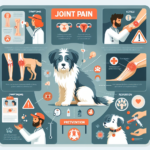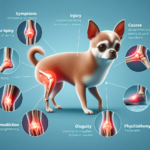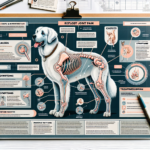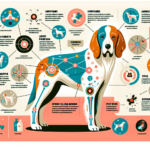Eurasier Joint Pain: Causes, Symptoms, Prevention, and Treatment

Introduction
The Eurasier is a relatively modern breed, developed in Germany in the 1960s by Julius Wipfel. This breed was created by crossing the Chow Chow, the Wolfspitz (Keeshond), and later the Samoyed, to combine the best traits of these breeds. Eurasiers are known for their calm demeanor, intelligence, and strong bond with their families. They are medium-sized dogs with a thick double coat, erect ears, and a bushy tail that curls over their back.
While Eurasiers are generally healthy dogs, they are not immune to health issues. Common concerns include hip dysplasia, patellar luxation, and hypothyroidism. Among these, joint pain is a significant issue that can affect their quality of life.
Joint health is particularly important for Eurasiers due to their active nature and genetic predisposition to certain joint issues. Maintaining good joint health can help ensure that these dogs remain active and comfortable throughout their lives.
Breed-Specific Joint Pain Risks
Genetic Predisposition
Eurasiers have a genetic predisposition to several joint-related issues, most notably hip dysplasia and elbow dysplasia. Hip dysplasia is a condition where the hip joint does not fit properly into the hip socket, leading to pain and arthritis over time. Elbow dysplasia involves abnormal development of the elbow joint, which can also result in pain and lameness. Both conditions are hereditary and can be exacerbated by environmental factors.
Age-Related Risks
As Eurasiers age, they become more susceptible to joint pain and arthritis. While these issues can develop at any age, they are more common in older dogs. Owners should be particularly vigilant as their Eurasier approaches middle age, typically around 5-7 years old, as this is when joint issues are more likely to manifest.
Activity Level and Joint Stress
Eurasiers are active dogs that enjoy regular exercise and play. However, their activity level can contribute to joint stress, especially if they engage in high-impact activities like jumping or running on hard surfaces. While exercise is essential for their overall health, it is crucial to balance activity levels to avoid putting excessive strain on their joints.
Common Symptoms of Joint Pain in Eurasiers
General Symptoms
- Limping or favoring one leg
- Stiffness, especially after resting
- Reluctance to move, jump, or climb stairs
- Decreased activity or playfulness
- Swelling around the joints
- Whining or showing signs of discomfort when touched
Breed-Specific Symptoms
In Eurasiers, joint pain may also manifest as a reluctance to engage in activities they previously enjoyed, such as long walks or playing fetch. They may also show changes in their gait, such as a bunny-hopping motion when running, which can indicate hip dysplasia.
When to Consult a Vet
If you notice any of the above symptoms in your Eurasier, it is essential to consult a veterinarian. Early diagnosis and treatment can significantly improve the quality of life for dogs with joint pain. Persistent limping, noticeable discomfort, or any sudden changes in behavior should prompt a veterinary visit.
Preventive Measures for Joint Health
Exercise Recommendations
Regular, low-impact exercise is crucial for maintaining joint health in Eurasiers. Activities such as walking, swimming, and gentle play are excellent options. Avoid high-impact activities like jumping or running on hard surfaces, as these can exacerbate joint issues. Aim for consistent, moderate exercise rather than sporadic, intense sessions.
Dietary Suggestions
A balanced diet rich in essential nutrients can support joint health. Look for dog foods that contain glucosamine and chondroitin, which help maintain cartilage health. Omega-3 fatty acids, found in fish oil supplements, can also reduce inflammation and support joint function. Consult your veterinarian for specific dietary recommendations tailored to your Eurasier’s needs.
Weight Management
Maintaining a healthy weight is crucial for reducing joint stress. Excess weight puts additional pressure on the joints, exacerbating pain and discomfort. Monitor your Eurasier’s weight and adjust their diet and exercise routine as needed to keep them at an optimal weight. Your veterinarian can provide guidance on the ideal weight range for your dog.
Early Screening and Monitoring
Regular veterinary check-ups are essential for early detection of joint issues. Screening tests such as X-rays can help identify conditions like hip dysplasia before they become severe. Early intervention can slow the progression of joint problems and improve your dog’s quality of life.
Treatment Options for Joint Pain
Non-Surgical Treatments
Non-surgical treatments for joint pain in Eurasiers include medications, physical therapy, and lifestyle adjustments. Nonsteroidal anti-inflammatory drugs (NSAIDs) can help manage pain and inflammation. Physical therapy, including exercises and hydrotherapy, can improve joint function and reduce pain. Lifestyle adjustments, such as providing a comfortable bed and avoiding high-impact activities, can also make a significant difference.
Surgical Options
In severe cases, surgical intervention may be necessary. Common surgical options for joint pain include:
- Hip Replacement: Replacing the damaged hip joint with an artificial one.
- Elbow Surgery: Correcting abnormalities in the elbow joint to reduce pain and improve function.
- Arthroscopy: A minimally invasive procedure to remove damaged tissue or repair joint structures.
Surgery should be considered when non-surgical treatments are no longer effective, and the dog’s quality of life is significantly impacted.
Alternative Therapies
Alternative therapies can complement traditional treatments and provide additional relief. Options include:
- Acupuncture: Inserting thin needles into specific points to relieve pain and improve joint function.
- Hydrotherapy: Using water-based exercises to reduce joint stress and improve mobility.
- Massage: Gentle massage can reduce muscle tension and improve circulation around the joints.
Consult your veterinarian before starting any alternative therapies to ensure they are appropriate for your Eurasier.
Lifestyle and Management Tips
Daily Care Routine
A consistent daily care routine can help manage joint pain in Eurasiers. This routine might include:
- Morning walk: A gentle walk to start the day and keep joints mobile.
- Midday rest: Allowing time for rest and recovery.
- Afternoon play: Engaging in low-impact play or swimming.
- Evening massage: Gentle massage to relax muscles and reduce tension.
Modifying the Home Environment
Making your home more comfortable for a dog with joint pain can significantly improve their quality of life. Consider the following modifications:
- Ramps: Install ramps to help your dog navigate stairs or get onto furniture without jumping.
- Orthopedic beds: Provide a supportive bed to reduce pressure on joints.
- Non-slip flooring: Use rugs or mats to prevent slipping on hard floors.
Long-Term Management
Long-term management of joint pain involves regular veterinary check-ups, consistent exercise, and a balanced diet. Monitoring your Eurasier’s condition and adjusting their care routine as needed can help them remain active and comfortable. Consider keeping a journal to track symptoms, treatments, and any changes in behavior.
FAQs About Eurasiers and Joint Pain
What are the early signs of joint pain in Eurasiers?
Early signs of joint pain include limping, stiffness, reluctance to move, and decreased activity. If you notice any of these symptoms, consult your veterinarian for an evaluation.
Can joint pain in Eurasiers be prevented?
While genetic predisposition cannot be changed, you can take preventive measures to reduce the risk of joint pain. These include regular exercise, a balanced diet, weight management, and early screening for joint issues.
Are there specific exercises that are better for Eurasiers with joint pain?
Low-impact exercises such as walking, swimming, and gentle play are ideal for Eurasiers with joint pain. Avoid high-impact activities that can exacerbate joint stress.
What dietary supplements can help with joint health in Eurasiers?
Supplements containing glucosamine, chondroitin, and omega-3 fatty acids can support joint health. Consult your veterinarian for specific recommendations tailored to your dog’s needs.
When should I consider surgery for my Eurasier’s joint pain?
Surgery should be considered when non-surgical treatments are no longer effective, and your dog’s quality of life is significantly impacted. Consult your veterinarian to discuss the best surgical options for your dog.
Conclusion
Joint pain is a common issue in Eurasiers, but with proper care and management, you can help your dog live a comfortable and active life. Early detection, preventive measures, and appropriate treatments are crucial for maintaining joint health. Regular veterinary check-ups and a balanced care routine can make a significant difference in your Eurasier’s quality of life. By taking proactive steps, you can ensure that your beloved pet remains happy and healthy for years to come.




